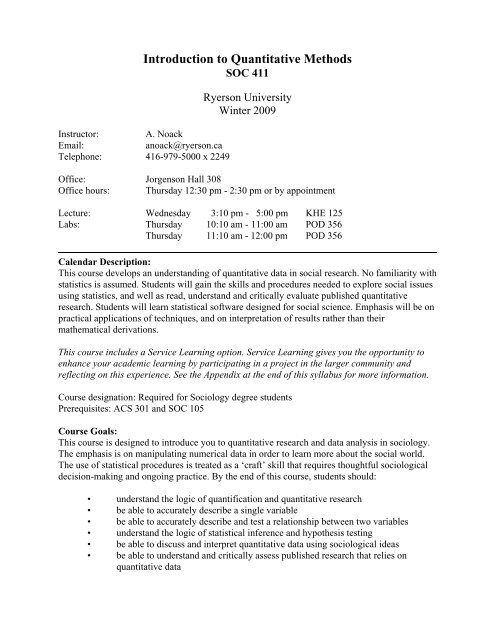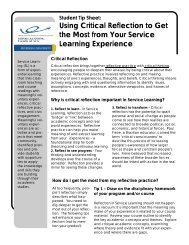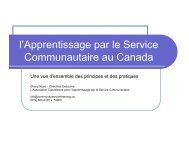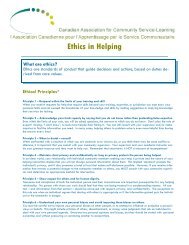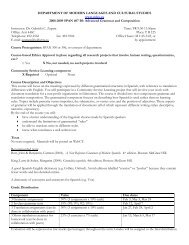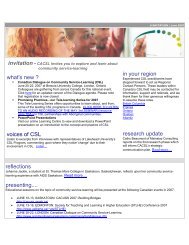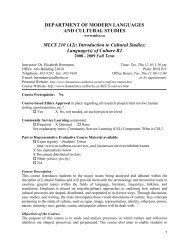SOC 411 - Canadian Association for Community Service Learning
SOC 411 - Canadian Association for Community Service Learning
SOC 411 - Canadian Association for Community Service Learning
Create successful ePaper yourself
Turn your PDF publications into a flip-book with our unique Google optimized e-Paper software.
Introduction to Quantitative Methods<br />
<strong>SOC</strong> <strong>411</strong><br />
Instructor: A. Noack<br />
Email:<br />
anoack@ryerson.ca<br />
Telephone: 416-979-5000 x 2249<br />
Ryerson University<br />
Winter 2009<br />
Office: Jorgenson Hall 308<br />
Office hours: Thursday 12:30 pm - 2:30 pm or by appointment<br />
Lecture: Wednesday 3:10 pm - 5:00 pm KHE 125<br />
Labs: Thursday 10:10 am - 11:00 am POD 356<br />
Thursday 11:10 am - 12:00 pm POD 356<br />
Calendar Description:<br />
This course develops an understanding of quantitative data in social research. No familiarity with<br />
statistics is assumed. Students will gain the skills and procedures needed to explore social issues<br />
using statistics, and well as read, understand and critically evaluate published quantitative<br />
research. Students will learn statistical software designed <strong>for</strong> social science. Emphasis will be on<br />
practical applications of techniques, and on interpretation of results rather than their<br />
mathematical derivations.<br />
This course includes a <strong>Service</strong> <strong>Learning</strong> option. <strong>Service</strong> <strong>Learning</strong> gives you the opportunity to<br />
enhance your academic learning by participating in a project in the larger community and<br />
reflecting on this experience. See the Appendix at the end of this syllabus <strong>for</strong> more in<strong>for</strong>mation.<br />
Course designation: Required <strong>for</strong> Sociology degree students<br />
Prerequisites: ACS 301 and <strong>SOC</strong> 105<br />
Course Goals:<br />
This course is designed to introduce you to quantitative research and data analysis in sociology.<br />
The emphasis is on manipulating numerical data in order to learn more about the social world.<br />
The use of statistical procedures is treated as a ‘craft’ skill that requires thoughtful sociological<br />
decision-making and ongoing practice. By the end of this course, students should:<br />
• understand the logic of quantification and quantitative research<br />
• be able to accurately describe a single variable<br />
• be able to accurately describe and test a relationship between two variables<br />
• understand the logic of statistical inference and hypothesis testing<br />
• be able to discuss and interpret quantitative data using sociological ideas<br />
• be able to understand and critically assess published research that relies on<br />
quantitative data
Weekly Topic and Reading Schedule:<br />
This course includes a weekly lecture and a lab session. The lectures will introduce the main<br />
ideas <strong>for</strong> each week; The lab sessions will give you the opportunity to apply the knowledge from<br />
the lectures and gain practical data analysis experience. Attendance at all lectures and lab<br />
sessions is critical in order <strong>for</strong> you to do well in this course.<br />
The textbook <strong>for</strong> this course is available in the Ryerson Bookstore:<br />
Haan, Michael (2009). An Introduction to Statistics <strong>for</strong> <strong>Canadian</strong> Social<br />
Scientists. Toronto: Ox<strong>for</strong>d University Press.<br />
A number of additional articles are used to supplement the textbook. These articles are intended<br />
to give you practice reading and understanding quantitative research results. Links to all of the<br />
additional readings can be found on the course Blackboard site. You will need a valid library<br />
barcode and PIN to access some of these readings from home.<br />
Date Topic/Activity Readings<br />
January 7 Introduction to Quantitative Data Analysis • Ch. 1: Why Should I Want to Learn Statistics?<br />
• Ch. 2: How Much Math Do I Need to Learn<br />
8 LAB: Introduction to the Arts Lab/SPSS<br />
Statistics?<br />
14 Univariate Analysis I: Describing Variables and<br />
Distributions<br />
• Ch. 3: Univariate Statistics<br />
• Clark, Delayed Transitions of Young Adults<br />
15 LAB: Variables, Values and Frequencies<br />
21 Introduction to Probability & The Normal Curve • Ch.4: Introduction to Probability<br />
• Ch.5: The Normal Curve<br />
22 LAB: Graphical Display in SPSS<br />
28 Univariate Analysis II: Measures of Central<br />
Tendency and Dispersion<br />
EXERCISE 1 DUE<br />
29 LAB: Means & SD; Medians & IQR<br />
• Ch 6: Measures of Central Tendency &<br />
Dispersion<br />
• Ch 7: Standard Deviations, Standard Scores &<br />
the Normal Distribution<br />
• Frank, Studying and Working<br />
February 4 Samples and Populations • Ch. 8: Samples and Populations<br />
• Ch. 9: Generalizing from Samples to<br />
5 LAB: Standard Errors and Confidence Intervals<br />
Populations<br />
11 MIDTERM TEST None<br />
12 No labs this week<br />
18/19 Reading week - no classes<br />
25 Bivariate Analysis I: Relationships between<br />
Discrete Variables<br />
• Ch. 12: Bivariate Statistics <strong>for</strong> Nominal Data<br />
26 LAB: Lambda & Gamma<br />
2
March 4 Bivariate Analysis I: Relationships between<br />
Discrete Variables (cont’d)<br />
EXERCISE 2 DUE<br />
• Ch. 13: Bivariate Statistics <strong>for</strong> Ordinal Data<br />
• Schellenberg, Perceptions of <strong>Canadian</strong>s<br />
5 LAB: Crosstabulations and Chi-square<br />
11 Bivariate Analysis II: Relationships between<br />
Discrete and Continuous Variables<br />
12<br />
LAB: Comparing Means & ANOVA<br />
• Ch.10: Using the t-Distribution to Compare the<br />
Means of Population Subgroups to<br />
Population Means<br />
• Ch. 15: One-Way Analysis of Variance<br />
• Clark, Pockets of Belief<br />
18 Bivariate Analysis III: Relationships between<br />
Continuous Variables<br />
EXERCISE 3 DUE<br />
19 LAB: Correlations & Scatterplots<br />
• Ch. 14: Bivariate Statistics <strong>for</strong> Interval/Ratio<br />
Data<br />
• Gadbois & Bowker, Gender Differences in the<br />
Relationships between Extracurricular<br />
Activities Participation...<br />
25 Regression I: Bivariate Predictions • Ch. 16: Regression 1 - Modelling Continuous<br />
26 LAB: Linear Regression<br />
Outcomes<br />
April 1 Regression II: Multivariate Predictions<br />
EXERCISE 4 DUE<br />
2 LAB: Multivariate Regression & Residuals<br />
8 Looking Back and Looking Ahead<br />
PARTICIPATION SELF-EVALUATION<br />
• Ch. 18: Regression Diagnostics<br />
• Gazso-Windle & McMullin, Doing Domestic<br />
Labour<br />
None<br />
9 LAB: Final Exam Review/Study Session<br />
Student Evaluation:<br />
Data Analysis Exercises (4 x 12% each) 48% 1: January 28, 2009<br />
2: March 4, 2009<br />
3: March 18, 2009<br />
4: April 1, 2009<br />
Midterm Test 20% February 11, 2009<br />
Final Exam 20% Scheduled by the registrar<br />
Lecture & Lab Participation 12% Ongoing<br />
The final day to drop a winter course is March 17. The faculty course survey will be administered<br />
from March 18- April 7.<br />
Students who are registered with the Access Centre should speak with me during the first week of<br />
class in order to arrange appropriate accommodations. Students who find that the schedule in this<br />
course conflicts with their religious observances should speak with me during the first two weeks of<br />
class in order to arrange appropriate accommodations.<br />
3
About the Data Analysis Exercises<br />
The best way to learn quantitative data analysis is through ongoing practice and feedback. To<br />
facilitate this learning, this course is designed around a series of small exercises that will build on<br />
each other. The specific requirements of each exercise will be posted on the course blackboard site<br />
one week be<strong>for</strong>e each exercise is due.<br />
Exercises must be submitted during class time on the day they are due. Please keep a backup copy of<br />
all work that you submit. Exercises will normally be returned to students a week after they are<br />
submitted.<br />
You will work with your own Statistics Canada dataset <strong>for</strong> each exercise. These datasets will be<br />
labelled by last name and can be downloaded from the ‘Exercises’ area of the course Blackboard<br />
site. Because each student will have a slightly different dataset, your results will be different from<br />
other students in the class. In order to maintain standards of academic integrity, you must complete<br />
each exercise using your own dataset. It is your responsibility to ensure that all of the work that you<br />
submit in this course is your own, individual work.<br />
About the Midterm Test and Final Exam<br />
The midterm test and final exam in this course will ask you to apply the concepts that you have<br />
learned throughout the term. You will not be required to memorize any mathematical <strong>for</strong>mulae <strong>for</strong><br />
the test or exam; all required <strong>for</strong>mulae will be given to you with the test/exam.<br />
You must complete both the midterm test and the final exam in this course. If you do not complete<br />
both the test and the exam, you will automatically be assigned a grade of ‘F’ in the course.<br />
The <strong>for</strong>mat of the midterm test will be discussed during lecture on February 4. The <strong>for</strong>mat of the<br />
final exam will be discussed during lecture on April 8.<br />
About Class Participation<br />
Students will be evaluated on their ongoing participation in class discussions and lab activities.<br />
‘Participation' includes speaking, listening and engaging in both large and small group contexts.<br />
Being prepared <strong>for</strong> class by doing the readings in advance will ensure that you are able to<br />
meaningfully participate. Both the quality and the quantity of your participation will be assessed.<br />
Because you cannot participate in class if you do not attend, attendance will often be <strong>for</strong>mally or<br />
in<strong>for</strong>mally recorded.<br />
Part of your participation grade will be based on the completion of short activities that you will be<br />
asked to submit at the end of some labs. Another part of your participation grade will be based on a<br />
self-evaluation that you will complete in class on April 8. Students who do not complete a selfevaluation<br />
on that day will not be able to provide input into their participation grade. Participation<br />
grades will be assigned at the end of the term.<br />
In order to provide a classroom space where everybody is able to learn, it is imperative that you<br />
remain respectful of other people. Racist, sexist, classist, ageist, ableist, homophobic and other<br />
discriminatory behaviour, comments or activities are not acceptable.<br />
4
Technical Requirements <strong>for</strong> the Course:<br />
Mathematical Knowledge<br />
Some students may be worried about whether<br />
or not they have enough mathematical<br />
knowledge to do well in this course.<br />
Although this course does not emphasize<br />
mathematical <strong>for</strong>mulae or derivations, you<br />
will need some math skills. At the start of the<br />
course, you should:<br />
• be able to add, subtract,<br />
multiply and divide using<br />
a calculator<br />
• understand how brackets work in a mathematical equation<br />
• understand and be able to use mathematical ‘order of operations’ (BEDMAS:<br />
Brackets, Exponents, Division, Multiplication, Addition, Subtraction)<br />
• understand the idea of percentages, proportions and fractions<br />
• be able to calculate a percentage using a calculator<br />
• understand the idea of positive and negative numbers<br />
• understand and be able to calculate the ‘square’ or ‘square root’ of a positive or<br />
negative number using a calculator<br />
If you are unsure about your skills in any of these areas, please come and see me at the beginning of<br />
the term in order to refresh your skills. Chapter 2 in your textbook also provides a review of some<br />
math fundamentals.<br />
Some new mathematical skills and procedures will also be taught as part of this course. If any of<br />
these ideas become confusing, please come and talk with me as soon as possible.<br />
Participating in the <strong>Service</strong> <strong>Learning</strong> option in this course might also help you to become more<br />
com<strong>for</strong>table with basic math skills and increase your confidence about learning and doing<br />
mathematics. See the Appendix of the syllabus <strong>for</strong> more in<strong>for</strong>mation.<br />
Computing Resources<br />
The labs and exercises in this course use a computer program called the ‘Statistical Package <strong>for</strong> the<br />
Social Sciences’ (SPSS), version 15 or 16. You can access this software in the Arts Lab in POD 356.<br />
You can also access this software from other computers that are connected to the internet using<br />
Ryerson’s ‘Virtual Applications’ system.<br />
To access SPSS from outside the Arts Lab, go to https://vapps.ryerson.ca. The first time you use the<br />
system, you will need to download and install a small program that lets you connect with Ryerson’s<br />
server. Once you have downloaded the program, you will need to logon with your Matrix ID and<br />
password to use SPSS. For detailed instructions on how to use Ryerson’s Virtual Applications, go to<br />
http://www.ryerson.ca/acs/usersguide/virtualapps.htm<br />
5
At the end of your textbook, you will find a companion lab manual to SPSS that includes step-bystep<br />
instructions <strong>for</strong> the most common procedures. A series of SPSS help tutorials are also available<br />
on the department’s ‘Statistics in Sociology’ website.<br />
I recommend that you use a memory key to store and transport your electronic files <strong>for</strong> this course.<br />
Many of the data files that we will be using are too big to send as email attachments; a memory key<br />
is the most efficient way to transfer data.<br />
How to Succeed in this Course:<br />
Attend all of the lectures and labs<br />
I expect that students will attend all lectures and labs and arrive on time. Arriving late to class is<br />
disruptive <strong>for</strong> everyone. Regular attendance is necessary <strong>for</strong> you to successfully complete this<br />
course; Each week’s material builds on concepts and ideas from the previous weeks. The lectures<br />
will cover material that is not found in your readings and lab activities will give you important<br />
practical experience.<br />
Pay attention in class<br />
I strongly discourage the use of laptops in the classroom. It is especially difficult to take notes about<br />
statistical ideas on a word processor. Laptops also often provide a distraction <strong>for</strong> you and <strong>for</strong> other<br />
students around you. Students who do use laptops in the classroom will be asked to sit in a<br />
designated location in order to minimize the disruption to other students.<br />
Participate in the lectures and labs<br />
Lecture and lab participation <strong>for</strong>ms a key part of the learning in this course. Activities in lectures<br />
will give you the opportunity to practice interpreting quantitative data in a supportive environment.<br />
Lab activities will give you the opportunity to practice using statistical analysis software. Ask<br />
questions as soon as you encounter any difficulties.<br />
Although I realize that some students may be hesitant to speak in class, learning to effectively<br />
explain your ideas to other people is an important part of your university education. Students who<br />
have concerns about speaking in class should make an appointment with me at the beginning of the<br />
term so that we can develop some practical strategies <strong>for</strong> increasing your confidence and com<strong>for</strong>t in<br />
the classroom.<br />
Do the readings be<strong>for</strong>e you come to lecture<br />
You should complete the assigned readings prior to arriving in lecture each week. As you read, be<br />
sure to make notes about anything that is confusing and any questions you have and bring these to<br />
my attention. Students who do not keep up with the readings may find it difficult to understand and<br />
engage with the lecture and lab material.<br />
6
Do your own work<br />
Although I encourage you to help one another, the only way to learn this material is to work through<br />
the ideas and exercises yourself. All of the work that you submit in this course must be your own.<br />
Plagiarism will not be tolerated. Where there is a suspicion of plagiarism, students may be required<br />
to submit their work to www.turnitin.com<br />
Take advantage of the help offered by the Peer Support Tutors<br />
As part of a pilot program, the Faculty of Arts has arranged <strong>for</strong> Peer Support Tutors in this course to<br />
provide you with an additional source support <strong>for</strong> students learning statistics. Two fourth-year<br />
Ryerson sociology students are responsible <strong>for</strong> giving you in<strong>for</strong>mal, one-on-one help. They will be<br />
available during the lab time to help you with any computing issues, and one additional day a week<br />
to help you with any difficulties you have with manipulating data <strong>for</strong> your exercises.<br />
Consider doing the <strong>Service</strong> <strong>Learning</strong> option<br />
Many people believe that the best way to truly learn something is to teach it to someone else. The<br />
<strong>Service</strong> <strong>Learning</strong> option gives you this opportunity. You do not need to be particularly strong in<br />
mathematics to do the <strong>Service</strong> <strong>Learning</strong> option - you only need to be willing to learn. Participating in<br />
<strong>Service</strong> <strong>Learning</strong> will help you to apply your knowledge and to put the concepts you learn in this<br />
course into a larger context.<br />
Hand in your exercises on-time<br />
Keeping up with the data analysis exercises will help you to quickly identify any conceptual or<br />
technical misunderstandings. Late exercises will be penalized with a reduction of ½ a mark (out of<br />
10) per day. I will not accept exercises that are more than one week late. Keep a copy of all work<br />
that you submit. If you cannot submit your assignment in person, please place them in the sociology<br />
department drop box. DO NOT leave assignments under my office door or email them to me.<br />
Come and see me as soon as you find anything confusing<br />
For questions about the course content or understanding specific statistical ideas, it’s best to talk<br />
with me in person. Come and visit me during my office hours; if you cannot attend during the posted<br />
time, please contact me to arrange an alternate time to meet. I also spend quite a bit of time in my<br />
office, so you may want to try just dropping by to see if I’m available.<br />
For basic administrative questions, the best way to contact me is by email. Please use your<br />
@ryerson.ca email to contact me - there is no guarantee that other emails will be delivered to my<br />
inbox. I check my email regularly, and will endeavour to respond to you within 48 hours. If you<br />
have not heard back from me after 48 hours, please send a second email to confirm that I received<br />
your original message.<br />
ENJOY THE COURSE!<br />
7
Appendix A:<br />
<strong>Service</strong> <strong>Learning</strong> Option<br />
What is the <strong>Service</strong> <strong>Learning</strong> (SL) Option <strong>for</strong> this Course?<br />
This <strong>Service</strong> <strong>Learning</strong> option in this course gives students the opportunity to teach basic data<br />
management concepts to Grade 8 students from Ryerson <strong>Community</strong> Public School. The emphasis<br />
will be on using mathematics as a tool <strong>for</strong> learning more about the people and community around<br />
Ryerson Public School.<br />
Ryerson <strong>Community</strong> Public School is located in the Kensington-Chinatown area of Toronto. Almost<br />
two-thirds of students come from homes where English is not the first language. Approximately one<br />
in every ten Ryerson PS students have been living in Canada <strong>for</strong> two years or less, and one in five<br />
students have been living in Canada <strong>for</strong> five years or less. Over the past decade, changes to the<br />
education funding model in Ontario have resulted in fewer resources <strong>for</strong> ESL programs and<br />
educational assistants in Toronto elementary schools.<br />
Many of the students in the Grade 8 class we are paired with are working below their grade level.<br />
Students from <strong>SOC</strong> <strong>411</strong> will work with Grade 8 students in a group tutoring program we are calling<br />
the Ryerson 2 Program. The goal <strong>for</strong> the Ryerson PS students is to build their math confidence and<br />
skills, as well as to introduce them to university students and post-secondary education. The goal <strong>for</strong><br />
Ryerson U students is also to become more com<strong>for</strong>table with math, and to solidify your knowledge<br />
of data management and statistics by teaching key concepts to others.<br />
Some concepts covered in the early part of this course overlap with data management curriculum <strong>for</strong><br />
Grade 8 students. In the first part of the Winter term, Ryerson U students will learn this material,<br />
visit a Ryerson PS Grade 8 math class, and attend a session on effective tutoring. You will then<br />
develop a worksheet that teaches a basic data management concept and also illustrates some aspect<br />
of the social world around Ryerson PS. Following the February break, Ryerson U students will meet<br />
weekly with Ryerson PS students to provide tutoring and build students’ skills and confidence. In<br />
the first two weeks, you’ll be assisting Ryerson PS students with textbook problems. In the last four<br />
weeks, you will use your worksheet (and the worksheets of other people doing SL) when meeting<br />
with the Ryerson PS students.<br />
Why would I want to do <strong>Service</strong> <strong>Learning</strong>?<br />
Students who participate in the SL option will further develop their understanding of quantitative<br />
data analysis, practice their teaching skills and contribute to community development by promoting<br />
access to post-secondary education. This option was developed in order to help sociology students<br />
who feel they are not particularly strong in math build their confidence. It will also provide new<br />
challenges <strong>for</strong> students who are already quite com<strong>for</strong>table with their math skills.<br />
The SL option will also help you build career skills and gain practical community experience. This<br />
option might be particularly interesting to students who are considering a career in teaching.<br />
8
How do I apply <strong>for</strong> <strong>Service</strong> <strong>Learning</strong>? How will selections be made?<br />
If you are interested in the SL option, please complete the Student Application Form and a Police<br />
Reference Check Authorization Form (both available on the class Blackboard site) and submit them<br />
to Andie by noon on January 15.<br />
The Police Reference Check (PRC) is required by the Toronto District School Board because you’ll<br />
be working directly with youth. If there are offenses on your record, the PRC will come back to the<br />
organization as “not cleared”. The detailed in<strong>for</strong>mation is not revealed to the <strong>Service</strong> <strong>Learning</strong><br />
team or our community partners but rather is mailed to you. If you have a criminal record, you<br />
may still be able to volunteer if you choose to disclose your offense. The final decision rests with the<br />
community partner.<br />
Students will be in<strong>for</strong>med of selection decisions by January 19 and must confirm their intent to<br />
participate in the SL option no later than January 21. I hope that 10-12 students will participate in<br />
the SL option.<br />
How will <strong>Service</strong> <strong>Learning</strong> students be evaluated?<br />
SL students will have a slightly different assignment and evaluation structure than the other students<br />
in the course. The midterm exam, the final exam, and the lecture/lab participation component will be<br />
the same as <strong>for</strong> other students. The 2 nd and 3 rd data analysis exercises will also be the same as <strong>for</strong><br />
other students. The 1 st and 4 th data analysis exercises will be replaced by developing a worksheet,<br />
and completing two short reflection exercises. The deadlines <strong>for</strong> these items are slightly different <strong>for</strong><br />
students doing the SL option in order to accommodate the project schedule.<br />
SL Student Evaluation (items in bold are unique to SL students):<br />
Data Analysis Exercises (2 x 12% each) 24% Exercise 2: March 4, 2009<br />
Exercise 3: March 18, 2009<br />
Reflexive Exercises (2 x 6% each) 12% Reflection 1a: January 27, 2009<br />
1b: February 4, 2009<br />
Reflection 2: April 8, 2009<br />
Worksheet Development 12% February 25, 2009<br />
Midterm Test 20% February 11, 2009<br />
Final Exam 20% Scheduled by the registrar<br />
Lecture & Lab Participation 12% Ongoing<br />
9
SL Activities Timeline:<br />
Thurs. January 15, noon<br />
January 19-21<br />
January 23-February 2<br />
Wed. January 28, 9-11 am<br />
Tues. February 3, 5-7 pm<br />
SL Applications due to Andie by noon<br />
SL students selected and confirmed<br />
participate in an orientation to SL and learning through experience<br />
Ryerson University students visit Ryerson PS<br />
Tutor training with Jason and Jack; select worksheet concepts<br />
Ryerson 2 Program Dates:<br />
February 26, March 5, March 12, March 26, April 2, and April 9<br />
(no session on March 19 because of March Break;<br />
bring worksheets starting on March 12)<br />
Lunch session: 12:00-12:30 (arrive at 11:45 and leave at 12:45)<br />
After-school session: 3:45 – 4:15 (arrive at 3:30 and leave 4:30)<br />
* Ryerson U students will attend either the lunch session or the after school session.<br />
Late March/Early April Ryerson Grade 8s visit Ryerson University, hosted by <strong>SOC</strong> 107<br />
You are welcome to join them in their activities, provided it does not<br />
interfere with your own classes.<br />
SL Reflection #1<br />
About 4 pages<br />
1a: Be<strong>for</strong>e the school visit: Go to the website www.torontohealthprofiles.com to find out more about<br />
the neighbourhood that the school is located in (the school is in the Chinatown-Kensington area).<br />
Using the data provided on the site, briefly describe two or three characteristics of the<br />
neighbourhood and explain how it compares to Toronto more generally. Focus on data that capture<br />
social inequalities, and use a sociological perspective to interpret your findings. In a paragraph,<br />
describe your expectations about the Ryerson PS students you will be working with. (About 2<br />
pages). This portion of the reflection is due on January 27 th - but the exercise will not be graded<br />
until after the second part of the reflection is submitted.<br />
1b: During and after the school visit: During the school visit on January 28 th , observe the classroom<br />
and the teacher carefully. Identify the strategies that the teacher uses to introduce and illustrate<br />
concepts to students. Explain which teaching strategies seem to be the most effective and which<br />
teaching strategies seem to be less effective, and speculate about why. Give specific examples from<br />
your observations in your descriptions. Based on your observations, describe the strategies that you<br />
think will be most useful when tutoring these students and explain why you think they will be useful.<br />
(About 2 pages). This portion of the reflection is due on February 4 th . Your reflections in this<br />
component may be shared with the teacher you are working with.<br />
10
Worksheet Development<br />
Worksheet: 1-2 pages<br />
Written explanation: 2-3 pages<br />
Choose a basic data management concept to develop a worksheet about. Please coordinate with<br />
other students to make sure that you do not duplicate topics. Using the instructions provided in the<br />
February 3 rd workshop, develop a worksheet that highlights some aspect of people’s health in the<br />
Ryerson PS neighbourhood compared to people’s health in Toronto overall. These data are<br />
available in the SL section of the course Blackboard site. More in<strong>for</strong>mation about these data and<br />
interactive maps are available at www.torontohealthprofiles.ca.<br />
Possible worksheet concepts include:<br />
• making and interpreting frequency tables<br />
• making and interpreting stem and leaf plots<br />
• making and interpreting bar graphs<br />
• making and interpreting pie graphs<br />
• the difference between a sample and a population<br />
• using percentages to make comparisons between groups<br />
Develop a 1-2 page worksheet that will help a Ryerson PS student learn the concept you have<br />
selected. Your worksheet should begin by setting out a problem, and then guide the students through<br />
the steps needed to solve the problem with a series of simple instructions and/or questions. Be sure<br />
to include some questions that will help the student to use math as a tool <strong>for</strong> understanding more<br />
about their community and social world.<br />
In 2-3 pages, explain the decisions you made when you developed your worksheet. Be sure to:<br />
• identify the data management concept that you are illustrating in your worksheet<br />
• identify the key elements that a student needs to understand in order to be able to apply<br />
this concept<br />
• explain how the worksheet guides the student through these key elements<br />
• explain how the worksheet helps the student to use the results to understand their social<br />
world<br />
When you hand in this project, please submit a blank worksheet, a worksheet that you have<br />
completed with the correct answers, and your written explanation. You will be evaluated on both the<br />
quality of your worksheet and the written explanation that you provide.<br />
You are encouraged to revise your worksheets after receiving feedback from Andie and working<br />
with the Grade 8 students <strong>for</strong> the first two weeks. Once you bring your worksheet to the class <strong>for</strong> the<br />
first time and distribute it to other SL students, please do not make any further changes.<br />
11
SL Reflection #2<br />
About 4 pages<br />
Assess the effectiveness of your worksheet as a teaching tool <strong>for</strong> illustrating your statistical concept.<br />
What aspects of the worksheet were particularly useful <strong>for</strong> the Ryerson PS students? What aspects of<br />
the worksheet were confusing <strong>for</strong> the Ryerson PS students? Explain how you know this, using<br />
specific examples from your interactions with the Grade 8 students. Explain how you would change<br />
your worksheet to make it a more effective teaching tool and to better illustrate your data<br />
management concept. Be sure to give a rationale <strong>for</strong> each of your changes. (About 2 ½ pages).<br />
Based on your experiences while tutoring and in this course more generally, identify some of the<br />
things that hinder people’s learning about mathematics and statistics. Speculate about the best<br />
strategies <strong>for</strong> overcoming these barriers. Explain why numeracy and statistical literacy are useful<br />
tools <strong>for</strong> understanding the social world. Go back and review the initial expectations you identified<br />
in your first reflection paper. Then, in a paragraph, briefly reflect on your interactions with the<br />
Ryerson PS students, and describe how your experiences met or challenged the expectations you<br />
originally had. (About 1 ½ pages).<br />
Please also submit a copy of the final worksheet that you used with students along with your written<br />
work.<br />
Additional <strong>Service</strong> <strong>Learning</strong> Requirements<br />
<strong>Service</strong> <strong>Learning</strong> students will be required to devote more time to this course than other students.<br />
This extra time will include activities such as the training sessions and the time spent at Ryerson PS.<br />
SL students will be graded on their academic assignments not the additional time they have<br />
volunteered. Your timeliness and attendance are important, however, to ensure that the Ryerson PS<br />
students are not disappointed. Remember - you are representing Ryerson University in these<br />
interactions with community members. Students who are not able to conduct themselves in a<br />
professional way will be asked to leave the SL program.<br />
A copy of the worksheet that you produces will be kept by the Grade 8 teacher you are working<br />
with, and may be used by the teacher/school in future years. Andie or the SL office may also use the<br />
worksheets as examples in future years.<br />
During this project, students may become aware of sensitive in<strong>for</strong>mation about Ryerson PS students<br />
or community members as a result of their weekly interactions at the school. SL students are asked<br />
to keep all in<strong>for</strong>mation confidential during and after their service. This includes not identifying any<br />
person they meet in SL by name or including identifying in<strong>for</strong>mation in their reflection assignments.<br />
At the SL orientation, you must also complete the following SL Program paperwork: Student<br />
Agreement Form, Assumption of Risk and Indemnity Agreement, and an Emergency Contact Form.<br />
Travel off of Ryerson’s campus is required <strong>for</strong> SL students. A limited number of TTC tokens are<br />
available from the SL Office (JOR-344J) <strong>for</strong> students who find this expense a barrier to<br />
participation. Please contact Lia at ldepauw@arts.ryerson.ca to arrange <strong>for</strong> tokens.<br />
12


